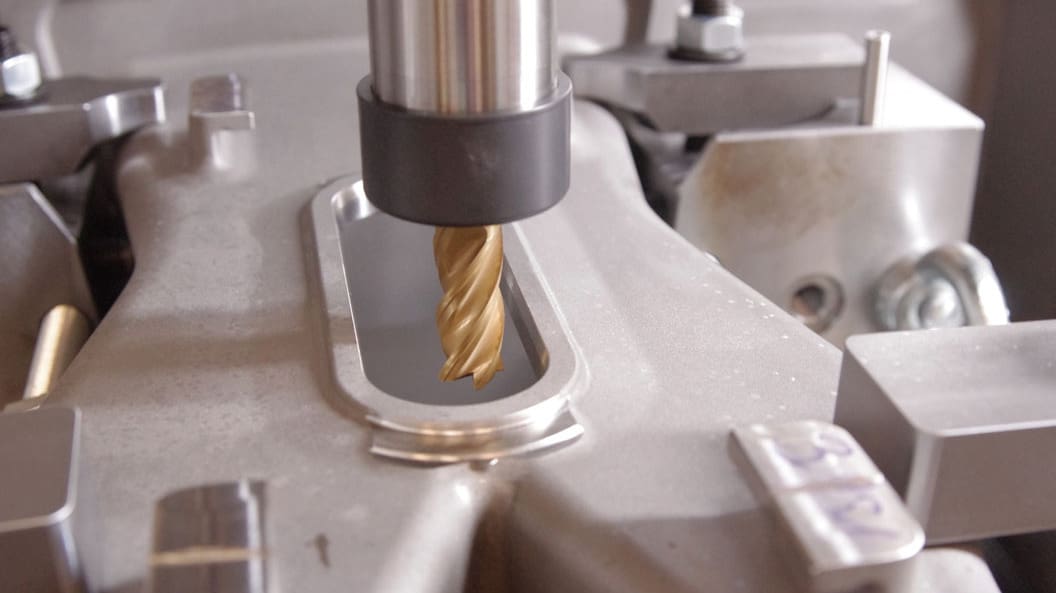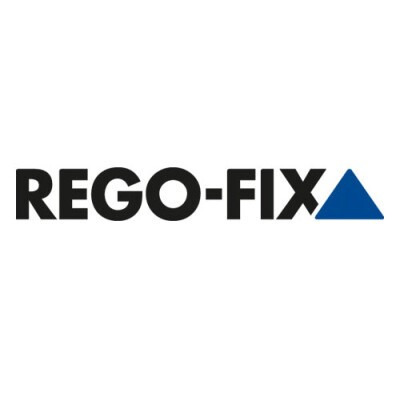Stable conditions with powRgrip
Discover why Franke Industrie AG, a worldwide player in the aerospace and power generation industry, ditched shrink-fit and switched to powRgrip to increase profitability.
Stable conditions – no tools pulled out
Franke Industrie AG in Aarburg, Switzerland, manufactures components from high-quality, heat resistant workpiece material as single pieces or in small series for the aerospace industry and for gas turbines for energy generation. This is only economically feasible with top process reliability, something which the powRgrip clamping system from Rego-Fix ensures.
‘Reliable processes determine our success,’ reports Markus Fretz in Aarburg He manages production at Franke Industrie AG. The indus trial company is a Swiss subsidiary of the international Franke consortium, which is active in four business areas and employs around 9,000 staff. The company distinguishes itself as the leading provider of products and solutions for home kitchens, private bathrooms, professional system catering, coffee preparation and public and semi-public washrooms.
From a molten mass to a component ready for installation
At Franke Industrie AG, around 70 employees specialise in components for the aerospace industry and energy generation systems. The company manufactures so-called hot gas path components for gas turbines of all sizes and turbines on commercial aircraft from corrosion-resistant steels and highly heat-resistant metal workpiece materials. ‘We process virtually all components for the hot areas of gas turbines with the exception of the blades,’ explains Miguel Hofer. As a sales engineer, he is the point of contact for manufacturers of gas turbines and aircraft turbines. Franke Industrie AG also manufactures exotic components such as outlet nozzles for the Ariane 5 rocket from ESA. The product portfolio in Aarburg includes diverse forming and welding procedures, mechanical machining, laser processes and water-jet machining as well as various destruction-free testing procedures. The company is also a member of the Turbine Components Network technology network.
‘Our specialisation in components for energy generation and, in particular, the aerospace industry brings with it especially stringent production process and component-quality requirements,’ explains Hofer. The entire company is audited and certified according to EN 9100 and customer-specific requirements. ‘Our customers demand top reliability from the components we produce,’ he adds.
Sophisticated machining
The workpiece materials machined at Franke in Aarburg set high standards for the production technology. According to Fretz, highly heat-resistant nickel–cobalt alloys are particularly difficult to clamp. ‘We try to do most of the required machining through forming, for example by bending and deep drawing sheet metal. Complex components are generally created by joining sheet metal, pipes, rings or individual pre-forged parts. This means that we need to have numerous welding workstations,’ he adds.
There are, however, several geometries and contours which cannot be machined using this procedure. These include small bores with diameters of only a few tenths of a millimetre, which are part of the air supply component in burner systems. Franke Industrie AG uses a laser procedure to create these bores. But, larger openings and, for example, mounting surfaces also need to be machined and edges smoothed. ‘Despite challenging conditions, milling is still inevitable,’ Says Fretz. To meet this demand, Franke Industrie AG has invested in several stable, three- and five-axle machining centres. They each have working areas of up to 1,000 × 600 × 500 mm. Their rotary tables can bear workpieces weighing up to 1,000 kg and measuring up to 1,000 mm in diameter. The vertical, directly driven spindles, with over 30 kW of drive power, can hold tools in large, stiff SK40 to HSK-A100 tool-holders. Primarily single pieces or series of five to 100 identical components are machined.
Tool holding with shrink-fit tool-holders was unreliable
To clamp milling tools, Franke Industrie AG first used conventional collets, Weldon chuck and shrink-fit tool-holders. These methods were insufficient, however. As Fretz explained, these tool clamping systems primarily lacked the necessary process reliability. ‘There are high axial forces when milling contours with an end mill. This is especially noticeable when very tough, heat-resistant workpiece materials are machined and when we are working with high feed rates,’ he adds, describing the causes. The axial forces can pull the milling tool out of the tool-holder. Fretz explains that this was observed repeatedly when clamping tools with standard collets. Even the shrink-fit chuck, which was frequently used, could not provide the necessary process reliability. He goes on to say that primarily the reliable operating life of these clamping systems could not be reliably predicted and determined. ‘The clamping force of shrink-fit chucks can start to fail after several hundred to several thousand shrink cycles. It is impossible for us to work with this high degree of unreliability,’ Fretz continues. Hofer adds: ‘If the milling tool is pulled out by machining forces, it usually irreparably damages the component. It is essential for us to avoid producing these kinds of reject parts.’ Reject parts result not only in economic losses but also slow down throughput times and component shipping. Special, highly heat-resistant custom materials are very expensive.
secuRgrip also provides positive mechanical engagement
Because of the repeated failures of shrink-fit chucks for clamping milling tools, the team in Aarburg started looking for a significantly better clamping system. The most important characteristic was excellent protection of the milling tool from being pulled out of the tool-holder. ‘We wanted to avoid having to procure milling tools with specially primed shanks, however. We still needed to be able to use our solid carbide milling tool with a straight shank or Weldon surface,’ says Fretz, commenting on the selection criteria for a suitable clamping system. This criteria was highly important, since the tools wear down very quickly, meaning that replacements need to be procured often. Standard tools are much more economical than tools with custom shanks. After the first talks with Vischer & Bolli AG, Roland Wyss, application technician at the trading company, presented the innovative tool-clamping system powRgrip by Rego-Fix. The system comprises the PGU 9500 automatic clamping unit and a tool-holder featuring powRgrip collets. It was the collets that impressed the specialists at Franke Industrie AG the most, as the Rego-Fix offers the secuRgrip system for shanks with a Weldon surface in addition to the straight shanks for end mills. Here, a carbide driver grips the Weldon surface and a thread channel on the PG-SG collet. This way, the tool is gripped not only with the hydromechanical clamping force, but also with positive mechanical engagement, securing it from being pulled out by axial forces. An additional benefit of this grip is that the driver nearly fully compensates for the imbalance of the Weldon surface. This way, this clamping system and the powRgrip clamping system ensure concentricity of ≤3 µm. With the two clamping surfaces between the tool shank and the collet and the collet and the tool chuck, the clamping system also ensures optimised vibration damping.
The specialists at Franke Industrie were also impressed by the easy operation and reliable working procedure of the powRgrip clamping system. At the push of a button, drilling and milling tools ranging in diameter from 0.2 mm to 25.4 mm could be clamped in a matter of seconds. The operator simply needs to insert the adjusted clamping adapter and then the tool with the entire tool-holder in the clamping unit. Since there are tool-holders available for all common spindle interfaces, including SK, HSK, BT, BT+ and Capto, the powRgrip clamping system is universally applicable. The PGU 9500 clamping unit automatically detects the clamping pressure required for the tool-holder on the corresponding clamping adapter. This means that personnel do not need any additional expert knowledge. The PGU 9500 clamping unit controls the clamping procedure and the clamping force by itself. As confirmed by Micha Plüss, deputy team leader in mechanical production, operator errors and the incorrect clamping of tools have been eliminated
After several months in use on the production floor, the powRgrip clamping system has fully met the strict standards for top process reliability. ‘The clamped drilling and milling tools are gripped reliably. This is also true in challenging situations that put a lot of stress on the milling tools,’ Fretz adds. Experience shows that the momentum (over 1,000 Nm for a PG 32 collet) transferred from the straight shank is generally enough to reliably grip the milling tool. The secuRgrip with carbide driver provides additional reliability for milling tools subject to high stresses such as large wrap angles.
This high process reliability is also ensured for long periods. Roland Wyss explains that the manufacturer Rego-Fix guarantees reliable functionality for up to 20,000 tool changes. This is because the tool chucks are only subjected to stress in their elastic expansion range during automatic mechanical clamping. The specialists at Franke Industrie AG can confirm this dependability and process reliability without exception. ‘Clamping straight-shank end mills and milling tools with Weldon surfaces with the powRgrip and secuRgrip from Rego-Fix creates unparalleled process reliability on our production line. This is especially true for large tools with diameters above 16 mm. The Rego-Fix clamping system is an essential part of our success,’ says Fretz, summarising his positive experience with the system

